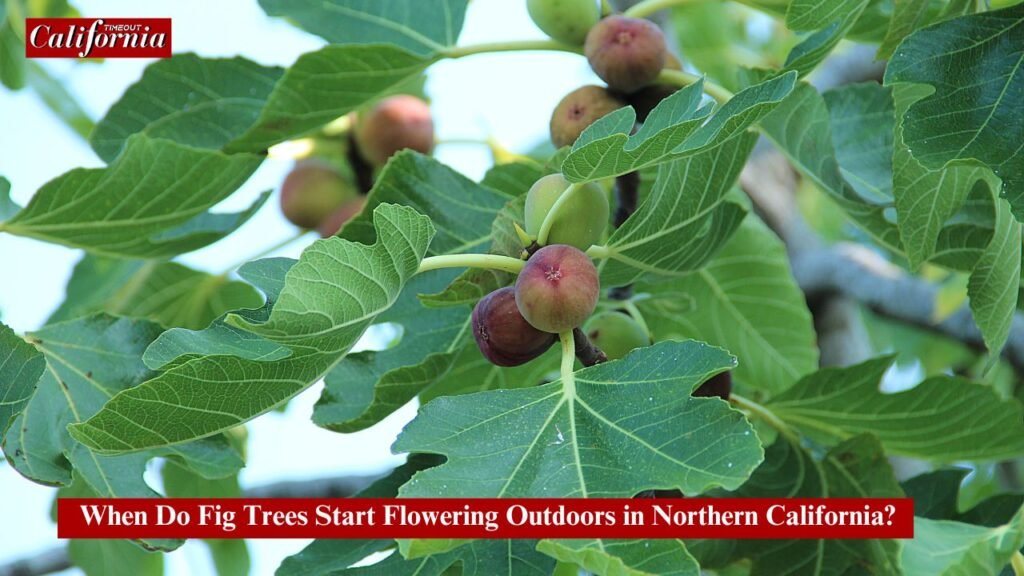Are you also looking to know When Do Fig Trees Start Flowering Outdoors in Northern California? Then this blog is suitable for you. Let’s define it and learn all about Fig Trees Start Flowering Outdoors.
Fig trees (Ficus carica) are a favorite among gardeners in Northern California and elsewhere because of their adaptability and delicious fruit. To ensure a bountiful harvest, it is important to understand the flowering and fruiting cycle of these trees.
Understanding the Fig Tree Flowering Cycle
Unlike many fruit trees, fig trees have a unique flowering process. Their flowers are not visible outside; they grow inside the fruit. This means that the fig tree flowers are in the fruit itself.
In Northern California, fig trees typically begin flowering during late spring or early summer, depending on the variety and local climatic conditions.

Factors Influencing Fig Tree Flowering in Northern California
1. Variety of Fig Tree
Northern California supports various fig varieties, such as:
- Black Mission: Popular for its rich flavor, flowers around late May to June.
- Kadota: A light-skinned variety that starts flowering in mid to late June.
- Brown Turkey: Known for its adaptability, it flowers from late May to early June.
2. Climate and Temperature
Fig trees thrive in Northern California’s Mediterranean climate, where warm temperatures encourage flowering. A consistent temperature of 60–85°F in spring is ideal for initiating their growth cycle.
3. Soil and Watering
Fig trees prefer well-draining soil with moderate moisture. Overwatering or poor drainage can delay flowering. Maintain a regular watering schedule during spring and summer to promote healthy development.
4. Sunlight
Full sun exposure is essential. Fig trees need at least 6-8 hours of sunlight daily to start flowering.
When to Expect Fruit After Flowering
After flowering, fig trees in Northern California typically produce fruit in mid to late summer. The time from flowering to harvest depends on the variety:
- Early varieties like Black Mission may fruit by late June.
- Late-season varieties like Kadota produce fruit by August or September.
How to Promote Flowering in Fig Trees

1. Pruning for Productivity
Prune your fig tree during winter dormancy to remove dead or weak branches. This encourages new growth and better flowering in spring.
2. Fertilization
Use a balanced fertilizer with nitrogen, phosphorus, and potassium in early spring. Avoid over-fertilization, as excess nitrogen can lead to foliage growth at the expense of flowering.
3. Pest and Disease Management
Common pests like fig beetles or nematodes can impact flowering. Use organic sprays or neem oil to protect your tree.
Challenges in fig tree blooming
Fig trees are a hardy and beneficial plant for any garden, but sometimes they can face challenges. Understanding and resolving these issues is the key to ensuring a healthy flowering cycle and abundant fruit production.

- Climate and Temperature Issues
- Late frosts and temperature fluctuations can damage buds.
- Use frost blankets and plant trees in sheltered areas.
- Soil Conditions
- Poor drainage or improper pH affects nutrient absorption.
- Test soil pH and amend with compost or lime; improve drainage with organic matter.
- Overwatering or Underwatering
- Overwatering leads to root rot; underwatering causes stress.
- Water deeply but infrequently; ensure proper drainage with drip irrigation.
- Nutritional Imbalances
- Excess nitrogen promotes foliage over flowers.
- Use balanced fertilizers and add phosphorus sources like bone meal.
- Insufficient Sunlight
- Fig trees need 6-8 hours of direct sunlight daily.
- Plant in sunny spots and trim nearby shade sources.
- Improper Pruning Practices
- Over-pruning or mistimed cuts remove flower buds.
- Prune during dormancy to remove weak or dead branches.
- Pests and Diseases
- Fig beetles, leaf spot, and nematodes weaken the tree.
- Inspect regularly and use organic pest management methods.
- Age and Maturity
- Young fig trees may take 2-3 years to bloom.
- Provide consistent care and patience for natural maturity.
- Stress from Transplanting
- Transplant shock can delay flowering.
- Minimize root disturbance and use rooting hormones post-transplant.
- Pollination Challenges
- Some varieties, like Smyrna figs, need specific pollinators (e.g., fig wasps).
- Plant self-pollinating varieties such as Black Mission or Brown Turkey.
FAQ:-
What is the best fertilizer for fig trees?
Use an organic fruit tree fertilizer that is a general purpose, slow-release, preferably with an 8-8-8 or 10-10-10 formula.
What time of year does the fig tree bud?
They die during winter and begin to sprout again in spring.
What is the best soil for fig trees in pots?
The best soil for fig trees in pots is well-draining, nutrient-rich soil with compost and perlite added for aeration.
Conclusion
In Northern California, fig trees generally begin flowering in late spring or early summer, depending on the variety, climate, soil, and sunlight. You can ensure a healthy, productive fig tree by following proper care techniques and using this knowledge.
- Breaking News: Bird Flu Outbreak California is becoming increasingly worrying
- These Knee Braces Help With Arthritis Pain, Swelling, and Post-Surgery Recovery
If you like this, When Do Fig Trees Start Flowering Outdoors in Northern California? Post, then comment and share your opinion with us. Attention Readers! Join us on WhatsApp Community for daily auto news updates.
You can follow Timeoutcalifornia on Twitter, Facebook, Instagram, and Google News. Visit Timeoutcalifornia.com for the most recent news, reviews, and tech guides. In my previous blog on How much is Sales tax in San Diego: A Comprehensive Guide!, I ended the post by linking to one of our final guides.


